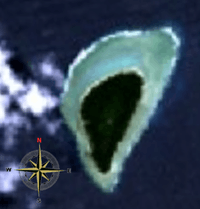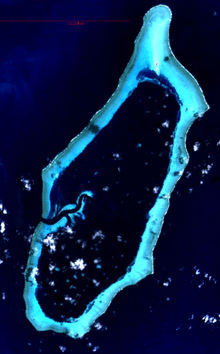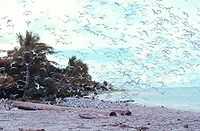Hatohobei

Tobi Island, or Hatohobei (Tobian language), is the southernmost of Palau's sixteen states, consisting of Tobi Island and uninhabited Helen Reef. The total land area is about 0.88 km². The population was 80 in 1962, 51 in 1995, and 23 in 2000, showing a steady decline over time, but 44 in 2005, showing a population rebound. Tobian, English and Sonsorolese language are the official languages of Hatohobei state.
The individual islands of Hatohobei, together with the islands of the state of Sonsorol, form the Southwest Islands of Palau.
| No. | Island | Village | Area (km²) | Population est. 2000 | Coordinates |
|---|---|---|---|---|---|
| 1 | Tobi (Hatohobei) | Hatohobei | 0.85 | 20 | 03°00′22″N 131°07′26″E / 3.00611°N 131.12389°E |
| 2 | Helen Reef (Hotsarihie) | marine ranger station | 0.03 | 3 | 02°57′N 131°47′E / 2.950°N 131.783°E |
| 3 | Transit Reef (Pieraurou) | - | - | - | 02°47′N 132°32′E / 2.783°N 132.533°E |
| State of Hatohobei | Hatohobei | 0.88 | 23 |

Tobi Island
Tobi (Hatohobei or Kodgubi) Island is the only inhabited island of the state (not counting the permanently manned Marine Ranger Station on the second island, Helen Island). The land area is 0.60 km². Its highest point is 6 m, while most of the island is less than 3 m high. Most of the houses are situated in the village of Tobi (Hatohobei) on the southwestern side of the island, the state capital. The island is covered with coconut palms. A cultivated area is situated near the center of the island. The island is fringed by a reef that extends up to 800 m from the shore in the north.

Helen Reef


Helen or Helens Reef (Hotsarihie), about 70 km east of Tobi Island, is a largely submerged atoll, with just one islet (Helen Island). The atoll is 25 km long and nearly 10 km wide, with a lagoon area of 103 km² and a total area including reef flat of 163 km². A channel leads into the lagoon from near the middle of the western side of the reef. Immediately south of the channel is Round Rock, which dries. The lagoon has about 85 patch and pinnacle Reefs.
When the tide is falling, the water flows out of the lagoon and over the reef in all directions until the reef is uncovered, and then flows out through the channel on the western side. On the rising tide, a reverse effect is noted. Only few parts of the reef completely dry.
Helen Island, the only island of the reef, is located near its northern tip. It is tiny in comparison to Helen Reef, about 20 to 40 m wide and 400 m long, or about 0.03 km² of land area. The densely wooded island sits atop a sand dune, which is 0.25 km² in extent and which is moving southeast, falling into the lagoon, at a rate 3 to 4 m per year. The island is uninhabited except for a marine ranger station of Hatohobei State, which was established in the early 1990s on the eastern side of the island, to guard the reef against foreign poachers. The station is permanently occupied by a staff of three.
Helen island was discovered by the Spanish naval officer Felipe Tompson in 1773, who charted it as San Felix shoal.[1]
Transit Reef
50 km east of Helen Reef is Transit Reef (Pieraurou), which appears on some maps and which is referenced as an island in the Hatohobei State constitution and constitutes the southermost feature of Palau. Its existence, however, is doubtful, as it is not listed in the current Sailing Directions. The literal translation of its Tobian name Pieraurou is "Sandy Navigation Point", referring to a submerged sand bar rather than a reef or island.
See also
References
- ↑ Brand, Donald D. The Pacific Basin: A History of its Geographical Explorations The American Geographical Society, New York, 1967, p.132.
External links
- Links to pictures and maps of Tobi and Palau.
- Aerial view of the island of Tobi.
- KiteLines FALL 1977 (Vol. 1 No. 3) Articles on Kite Fishing on Tobi.
- Helen Reef

